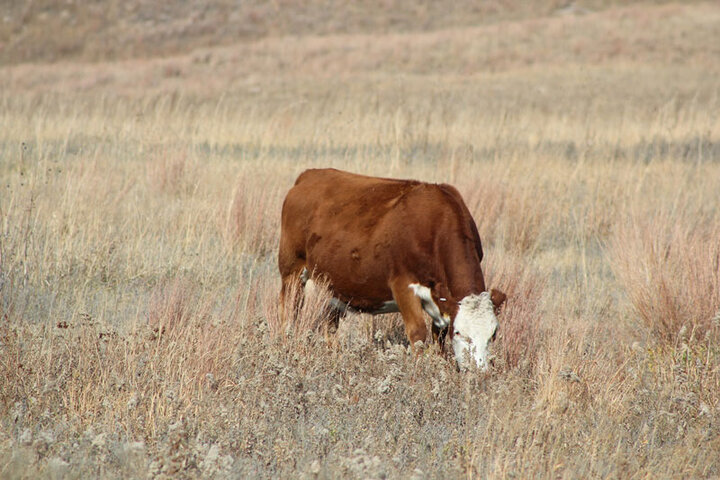Cow depreciation is frequently the second largest expense to the cow-calf enterprise after feed. Depreciation is a non-cash expense that is often overlooked by cow-calf producers. A recent webinar titled Cow Depreciation gives further details on how to manage and reduce this expense.
Depreciation for a cow is calculated as the following.
Purchase Price or Replacement Cost – Salvage Value
Productive Years in the Herd
Purchase price is the dollar value of the bred heifer or cow when she is bought and enters the herd.
For producers raising their own replacement heifers, replacement cost should include all costs starting with the costs to produce the weaned heifer calf till the time she enters the herd as a bred female.
To demonstrate how significant this expense can be, examine an example of current bred replacement heifer prices against today's cull cow values.
Bred Two-Year-Old Heifer = $2750
Average Cull Cow Value = $1500
Depreciation without death loss = $1250/head
The average number of productive years for most cows in a herd is somewhere from 3-5 years assuming a 10 - 20% cowherd replacement rate. Using five years, depreciation is $250.00 per head per year. At four years it is $312.50 per head per year and at three years it is $416.67. If you add in death loss at 2% on an average cow herd value of $2000 then depreciation expense jumps to $290.00 per head for five years, $352.50 for four and a $456.67 for three. Cow depreciation is a significant expense!
Aggressively identifying ways to reduce depreciation expense should be a goal for cow-calf producers. Depreciation can be reduced one of three ways.
- Reduce replacement heifer development costs or the purchase price for bred heifers/cows.
- Increase the salvage value of cows that are leaving the herd.
- Increase the number of years a cow is productive in the herd.
Let's take a look at each segment of the cow depreciation equation.
Purchase Price or Replacement Cost
Cow-calf producers who purchase bred replacement females need to evaluate the cost of those females against expected productivity and revenue that will be generated from them. When most cow-calf producers think of buying bred replacements, they probably are thinking of purchasing bred heifers. However, it may be that purchasing a different age group of cows would be more profitable and provide greater management flexibility.
Those cow-calf producers who raise and develop their own replacement heifers should enterprise replacement heifers separately from the cowherd to identify all of the costs involved. A producer should know their costs to produce a weaned heifer calf. At weaning the producer should on paper "sell" the weaned replacement heifers to the replacement heifer development enterprise at market value. The replacement heifer enterprise "buys" the weaned heifers and then develops the heifers into bred heifers that can be "sold" back to the cow-calf enterprise. Once the bred heifers are ready to enter the herd, the cow-calf enterprise then "buys" these bred heifers at market value.
While all of these transactions only occur on paper, and may seem unnecessary, it brings clarity to where expenses and revenue are being generated in the operations and which enterprises are profitable. Keeping track of all expenses, including a heifer's market value at weaning, that go into developing a bred replacement heifer is important to be able to identify opportunities to optimize development costs. For more information on developing replacement heifers see the UNL NebGuide "Reducing Replacement Heifer Development Costs Using a Systems Approach" (PDF version, 1.04MB).
Salvage Value
In the depreciation equation, increasing the "salvage" value of cows leaving the herd often provides the greatest opportunity to reduce depreciation. Frequently cow-calf producers pregnancy test spring calving cows and cull non-pregnant cows in the fall of the year. Other cows are frequently culled at this time as well for a plethora of reasons including age, attitude, udders, structure, lumps, bumps, etc. This time of the year is also historically when annual cull cow values tend to be lowest for the year.
The following are two examples of the ways that value can be added to cows leaving the herd increasing their worth and thus reducing depreciation expense.
- Have a long breeding season and a short calving season. The use of pregnancy diagnosis tools such as palpation and ultrasound can identify how far along a cow is in her pregnancy. Those cows that will calve later than the desired time period can be sold as bred cows. In today's market environment bred cows usually bring a significant premium to non-pregnant cows.
- Capture additional value from non-pregnant cows by adding weight and selling into a historically seasonally better market than the fall. The value of weight gain today for a cull cow can be quite amazing at current prices. This is especially true if you can move a cow from a "Lean" classification into a "Boner/Breaker" classification in a market where prices are increasing.
Productive Years in the Herd
Evaluate ways to cost effectively reduce cowherd turnover. The first reason cows are usually removed from the herd is because they are not pregnant. Young cows, especially those that are two or three years of age are often the most vulnerable. Older cows toward the end of their productive life can be vulnerable as well. There are several tools such as hybrid vigor, genetics that fit resources, health programs, development systems and strategic feeding/supplementation that can be used to cost effectively reduce cowherd turnover.
Cow depreciation is a significant expense. Cow-calf producers who aggressively manage to cost effectively reduce this expense will see an increase in their profit.
Topics covered:
Marketing, budgets & management, Budgets & cost of production

